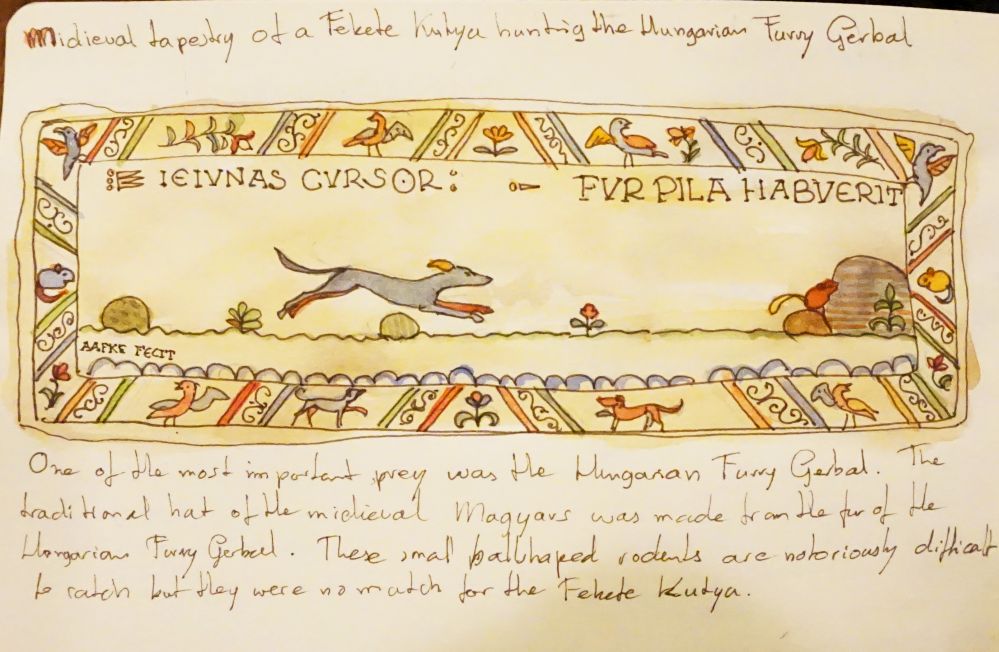From my sketch book:
One of the most rare dog breeds is the Hungarian sight hound, the ”Fekete Kutya”.
Appearance:
The Fekete Kutya is a medium sized dog, weighing 28 to 44 pounds. The height should be between 18 to 24 inches.
The only accepted color for the Fekete Kutya is black, with some white hairs, but no socks or markings larger than an inch in circumference. The coat is short, smooth and shiny. On the back runs a band of hairs with a coarser texture, the belly is only very lightly haired. Most Fekete Kutyas show a light feathering on the tail, in rare instances long feathering. This is accepted by the breed standard.
The Fekete Kutya should be of an elegant streamlined build, but never slight or delicate. The legs are long and straight, with a sizable paw. The back is straight, with a slight bend at the rear, a roach back is not acceptable. The tail is long and slender, with a slight upwards bend.
The head is long and narrow with a sharply pointed nose. The ears are small and floppy, but capable of many diverse expressions. The eyes are small, dark brown and have an almond shape.
Medieval tapestry, embroidered with coloured wool thread on linnen, showing a Fekete Kutya hunting the Hungarian Furry Gerbil.
Used for hunting, one of the most important prey animals for the Fekete Kutya was the now extinct Hungarian Furry Gerbil. The traditional hat worn by the medieval Magyars was made of Hungarian Furry Gerbil skin. These small, ball shaped rodents were notoriously difficult to hunt but proved no match for the speed and agility of the Fekete Kutya.
16th century engraving of an Hungarian nobleman wearing an Hungarian Furry gerbil hat, his favored Fekete Kutya at his side. The dogs were trained to ride on a special cushion attached to the saddle on certain occasions.
The Fekete Kutya became such an outstanding hunter of the Hungarian Furry Gerbil that the animal is now extinct. However, the hunt for these rodents is so ingrained in the Fekete Kutya’s genes, that even today all Fekete Kutya’s have an insane, deranged, and manic obsession with balls.
The Fekete Kutya is extremely fast, needs daily exercise, and preferably participation in sport. Especially flyball. In fact the modern sport of ”Flyball” originated from the medieval Furry Gerbil hunt.
When not exercising or at sport the Fekete Kutya will enjoy lounging on a luxury dog bed, next to you on the couch, in your bed, or actually on top of you.
The Fekete Kutya is famed for it’s intelligence, and these dogs are beyond compare in training humans. They also have a mind of their own. If, for example, the exercise offered is not up to par, according to the hound, they will conduct their own plan, which usually means running very fast around a building while the owner, trainer and various other persons call and yell for it to come back. However, the Fekete Kutya never listens to commands unless it feels like it.
As the sport of flyball is derived from The Gerbil Hunt, the Fekete Kutya is the most perfect dog for this sport. In fact the Fekete Kutya evolved with the sport. In the early 18th century both the Hungarian Furry Gerbil and the fashion for Hungarian Furry Gerbil hats were on the decline and instead of hunting the sport of flyball was invented and had started to become very fashionable in aristocratic circles.
18th century colored plate:
”Lady playing Balle Volant with her Fekete Kutya”
In the 18th century the first rules for flyball, or ”Le Sport de Balle Volent” as it was named due to the universal popularity of French as the European Lingua Franca, were established, and for the first time special equipment was designed for Balle Volent.
Three jumps, made of concave boards but with a fixed height were put out by the servants on a specially cut grass run, this was named ”La course”, At the end of la course was a square wooden contraption, ”La Boîte qui frapper la Balle”, it contained a rabbit fur covered ball and spring which, when pulled by a servant, would release the fur ball, ”Le Pouff”, in imitation of an Hungarian Furry gerbil. The dog would snap up the ”Pouff” and run back to it’s handler, who also had a Pouff on a silk ribbon, which was meant to entice the dog back and reward the dog by having another ”Pouff” to catch.
Stay tuned for Part Deux







Reblogged this on Clouddragon.
Love it!